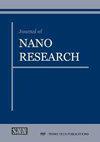Characterization of Enhanced Crystalline Structures of CdS Thin Films Deposited by Chemical Bath Deposition Caused by Doping with (Cu2+, Ag+, Au+) Transition Metal Ions
IF 1
4区 材料科学
Q4 MATERIALS SCIENCE, MULTIDISCIPLINARY
引用次数: 0
Abstract
In this work, the optical and structural properties of the modified crystalline structures of the nanostructured cadmium sulphide (CdS) semiconductor caused by doping with (Cu2+, Ag+, Au+) transition metal ions are studied. Using the chemical bath deposition technique, thin CdS films of good crystalline quality were deposited, which were doped in synthesis without the need for additional steps, obtaining thicknesses of around 100 nm. The chemical binding energies and their interactions of the CdS semiconductor compound with the different transition metal ions were determined by X-ray photoelectron spectroscopy. The crystalline and quality phase of the CBD-CdS thin films were determined by X-ray diffraction that were confirmed by Raman scattering, obtaining that the dominant crystalline phase is zinc blende in the (1 1 1) crystalline direction. A change in crystalline quality from monocrystalline to polycrystalline was observed by XRD in the CdS thin films doped with transition metal ions, keeping the crystalline direction (1 1 1) of the zinc blende phase of CdS as the dominant one; this crystalline behaviour was confirmed by HRTEM micrographs, in addition to the different levels of quantum confinement favoured by each transition metal incorporated into the CdS. By Raman scattering measurements, the crystalline zinc blende phase of CdS was confirmed and also allowed the analysis of the phononic interactions of the binary compound, where Raman shifts provided information on the structural quality and also confirm the effects of quantum confinement. UV-visible optical spectroscopy describes the effects of the crystalline structural modifications with blue shifts on the optical band gap energies of the evaluated CdS samples, related with the different levels of quantum confinement given by the (Cu2+, Ag+, Au+) transition metal dopants.掺杂(Cu2+、Ag+、Au+)过渡金属离子导致化学沉积法沉积的 CdS 薄膜晶体结构增强的表征
本文研究了纳米结构硫化镉(CdS)半导体因掺杂(Cu2+、Ag+、Au+)过渡金属离子而改变晶体结构的光学和结构特性。利用化学沉积技术沉积了结晶质量良好的 CdS 薄膜,这些薄膜在合成过程中掺杂,无需额外步骤,厚度约为 100 nm。通过 X 射线光电子能谱测定了 CdS 半导体化合物与不同过渡金属离子的化学结合能及其相互作用。通过 X 射线衍射确定了 CBD-CdS 薄膜的结晶相和质量相,并通过拉曼散射进行了确认。通过 X 射线衍射,观察到掺杂了过渡金属离子的 CdS 薄膜的结晶质量从单晶变为多晶,但仍以 CdS 锌混晶相的结晶方向(1 1 1 1)为主;这种结晶行为得到了 HRTEM 显微照片的证实,此外,CdS 中掺入的每种过渡金属都具有不同程度的量子约束。通过拉曼散射测量,确认了 CdS 的锌混合物结晶相,还分析了二元化合物的声波相互作用,拉曼位移提供了有关结构质量的信息,还确认了量子约束的影响。紫外-可见光学光谱描述了晶体结构变化对所评估的 CdS 样品光带隙能的影响,这些影响与过渡金属掺杂剂(Cu2+、Ag+、Au+)所产生的不同量子约束水平有关。
本文章由计算机程序翻译,如有差异,请以英文原文为准。
求助全文
约1分钟内获得全文
求助全文
来源期刊

Journal of Nano Research
工程技术-材料科学:综合
CiteScore
2.40
自引率
5.90%
发文量
55
审稿时长
4 months
期刊介绍:
"Journal of Nano Research" (JNanoR) is a multidisciplinary journal, which publishes high quality scientific and engineering papers on all aspects of research in the area of nanoscience and nanotechnologies and wide practical application of achieved results.
"Journal of Nano Research" is one of the largest periodicals in the field of nanoscience and nanotechnologies. All papers are peer-reviewed and edited.
Authors retain the right to publish an extended and significantly updated version in another periodical.
 求助内容:
求助内容: 应助结果提醒方式:
应助结果提醒方式:


